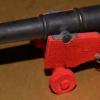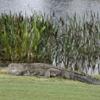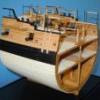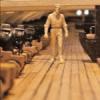MORE HANDBOOKS ARE ON THEIR WAY! We will let you know when they get here.
×
-
Posts
1,763 -
Joined
-
Last visited
Reputation Activity
-
 Mark P reacted to Waldemar in William Sutherland's concept of ship hull design, 1711
Mark P reacted to Waldemar in William Sutherland's concept of ship hull design, 1711
Nihil novi sub sole. 🙂
To conclude this thread, I also present a design draught of the Danish ship Printz Christian built in 1665, i.e. some 45 years before Sutherland's work was published. A quick check of the frame lines proves that this ship was designed on the conoidal solid principle, so that the cross-sections of the submerged part of the hull have the shape of a perfect arc with varying radii for different frames (Danish archives).
Moreover, the shape of the floor curves is somewhat 'suspicious', and I think that these bottom curves are also rather for illustrative purposes only on the plan, to be properly formed on the mould loft in the shipyard, as described in the Sutherland's work.
-

-
 Mark P reacted to Waldemar in William Sutherland's concept of ship hull design, 1711
Mark P reacted to Waldemar in William Sutherland's concept of ship hull design, 1711
Being fresh from reading a very interesting publication on the Restoration yachts of Charles II, I looked again at William Sutherland's work, The Ship-builders Assistant, 1711, focusing on his method of shaping ship hulls.
In his work, Sutherland proposes shaping ship hulls so that the submerged part of the hull takes the form of an (elongated) egg. Such a shape is called a conoid. Both the characteristic feature and result of such a form are frames with the profile of a perfect arc (connected by an additional line(s) to the keel and the posts). In addition, the radii of these arcs are different for each frame.
The very idea of using variable radius arcs for different frames was not entirely new at the time. Anthony Deane (1670) had already partly used this way to construct the profile of the frames (although not in the textual description, but in his drawings), the way described in the work of Georges Fournier (Hydrographie, 1643) can also be interpreted in this way, and there is a plan of the English origin in the Russian archives, in which the arc of the greatest breadth is based on the principle of variable radius (the plan is undated, but the ship has clear features specific for the turn of the 16th and 17th centuries, in particular the square-tuck stern and the considerable rakes of both posts).
Below I have shown my graphical interpretation of the method proposed by Sutherland. It should be stressed here that the original plan has some drawing anomalies and, moreover, does not quite match its textual description, so reverse engineering methods were also necessary to interpret it.
As can be seen, the conoid is only the body defined by the upper arcs, while the floor curves (also called hollow lines, bottom curves etc.) were constructed by Sutherland in the conventional way. Here, too, it must be added that Sutherland chose one way of drawing the floor curves in his drawing, while in the textual description he proposed a different method for use in the actual construction of the ship in true scale, but still using a simple template made of only two parts: a line and an arc. As a result, the theoretical shapes (as in the plan) and those of the actual ship had to come out slightly different.
-
 Mark P got a reaction from davyboy in The method of building, rigging, apparelling, & furnishing his Majesties ships of warr, according to their rates
Mark P got a reaction from davyboy in The method of building, rigging, apparelling, & furnishing his Majesties ships of warr, according to their rates
Good Evening Wayne;
Thanks for this. Battine was, if I remember correctly, clerk of the cheque at Portsmouth dockyard. He produced one of these books every year, and dedicated each of them to potential/actual patrons who could help with advancing or safeguarding his position. I am sure that at least a dozen different copies survive in various archives and collections. William Keltridge, a shipwright/ship's carpenter produced a similar book, in a similar size, which is more detailed, but of which I know of only one copy, and possibly one other. Keltridge knew his stuff, certainly, as he ended his career as the carpenter of the Royal Sovereign in the 1690s, the highest possible position for a ship's carpenter. I presume that he either died or was pensioned off shortly before the Sovereign burned, as he was not her carpenter by that date, and I have not seen any record of his appointment as an assistant master shipwright in a dockyard, which was the next step in a ship's carpenter's career. His work is not available as a pdf.
The various copies of Battine's book seem to be written in different hands, interestingly, with some very neat, and others noticeably less so.
Such books came into existence due to the need to educate ships' commanders who had not grown up at sea, and consequently were lacking in all but the most basic knowledge of ships. The competition for an appointment to the command of a warship was eagerly sought by many who considered it their birthright due to their rank in society; and their appointments were hotly contested by those who held themselves more suitable due to their hard-won experience of extensive sea-service. The debate and competition over which source provided the better commanders occupied a large part of the 17th century.
All the best,
Mark P
-
 Mark P reacted to trippwj in The method of building, rigging, apparelling, & furnishing his Majesties ships of warr, according to their rates
Mark P reacted to trippwj in The method of building, rigging, apparelling, & furnishing his Majesties ships of warr, according to their rates
I have only found the one digital version, so can't comment on the different penmanship. There is a copy listed in the R.C.Anderson papers at (I think) the RMG. The various handwriting may reflect having a clerk hand copy it to provide to another "patron". The dedications would be an interesting comparison.
-
 Mark P reacted to mtaylor in The method of building, rigging, apparelling, & furnishing his Majesties ships of warr, according to their rates
Mark P reacted to mtaylor in The method of building, rigging, apparelling, & furnishing his Majesties ships of warr, according to their rates
Not an uncommon thing about the "potential" captains. Seems to still be going on with all navies with politics and "friendship" counting more than experience. This is most notable at the admiral's level. Same for other branches of military service.
-
 Mark P got a reaction from allanyed in The method of building, rigging, apparelling, & furnishing his Majesties ships of warr, according to their rates
Mark P got a reaction from allanyed in The method of building, rigging, apparelling, & furnishing his Majesties ships of warr, according to their rates
Good Evening Wayne;
Thanks for this. Battine was, if I remember correctly, clerk of the cheque at Portsmouth dockyard. He produced one of these books every year, and dedicated each of them to potential/actual patrons who could help with advancing or safeguarding his position. I am sure that at least a dozen different copies survive in various archives and collections. William Keltridge, a shipwright/ship's carpenter produced a similar book, in a similar size, which is more detailed, but of which I know of only one copy, and possibly one other. Keltridge knew his stuff, certainly, as he ended his career as the carpenter of the Royal Sovereign in the 1690s, the highest possible position for a ship's carpenter. I presume that he either died or was pensioned off shortly before the Sovereign burned, as he was not her carpenter by that date, and I have not seen any record of his appointment as an assistant master shipwright in a dockyard, which was the next step in a ship's carpenter's career. His work is not available as a pdf.
The various copies of Battine's book seem to be written in different hands, interestingly, with some very neat, and others noticeably less so.
Such books came into existence due to the need to educate ships' commanders who had not grown up at sea, and consequently were lacking in all but the most basic knowledge of ships. The competition for an appointment to the command of a warship was eagerly sought by many who considered it their birthright due to their rank in society; and their appointments were hotly contested by those who held themselves more suitable due to their hard-won experience of extensive sea-service. The debate and competition over which source provided the better commanders occupied a large part of the 17th century.
All the best,
Mark P
-
 Mark P got a reaction from robert952 in The method of building, rigging, apparelling, & furnishing his Majesties ships of warr, according to their rates
Mark P got a reaction from robert952 in The method of building, rigging, apparelling, & furnishing his Majesties ships of warr, according to their rates
Good Evening Wayne;
Thanks for this. Battine was, if I remember correctly, clerk of the cheque at Portsmouth dockyard. He produced one of these books every year, and dedicated each of them to potential/actual patrons who could help with advancing or safeguarding his position. I am sure that at least a dozen different copies survive in various archives and collections. William Keltridge, a shipwright/ship's carpenter produced a similar book, in a similar size, which is more detailed, but of which I know of only one copy, and possibly one other. Keltridge knew his stuff, certainly, as he ended his career as the carpenter of the Royal Sovereign in the 1690s, the highest possible position for a ship's carpenter. I presume that he either died or was pensioned off shortly before the Sovereign burned, as he was not her carpenter by that date, and I have not seen any record of his appointment as an assistant master shipwright in a dockyard, which was the next step in a ship's carpenter's career. His work is not available as a pdf.
The various copies of Battine's book seem to be written in different hands, interestingly, with some very neat, and others noticeably less so.
Such books came into existence due to the need to educate ships' commanders who had not grown up at sea, and consequently were lacking in all but the most basic knowledge of ships. The competition for an appointment to the command of a warship was eagerly sought by many who considered it their birthright due to their rank in society; and their appointments were hotly contested by those who held themselves more suitable due to their hard-won experience of extensive sea-service. The debate and competition over which source provided the better commanders occupied a large part of the 17th century.
All the best,
Mark P
-
 Mark P got a reaction from allanyed in The Naiad Frigate by Ed Tosti
Mark P got a reaction from allanyed in The Naiad Frigate by Ed Tosti
Oops!
Apologies to Allan; I seem to have misunderstood the purpose of the question. It relates to the timber structure, not the metalwork on it.
All the best,
Mark P
-
 Mark P got a reaction from mtaylor in The Naiad Frigate by Ed Tosti
Mark P got a reaction from mtaylor in The Naiad Frigate by Ed Tosti
Oops!
Apologies to Allan; I seem to have misunderstood the purpose of the question. It relates to the timber structure, not the metalwork on it.
All the best,
Mark P
-
 Mark P got a reaction from mtaylor in The Naiad Frigate by Ed Tosti
Mark P got a reaction from mtaylor in The Naiad Frigate by Ed Tosti
Good Evening Allan;
I think that you will find that the longer of the metal fittings shown close together is a crutch for the main lower studding sail boom to rest in when it is not rigged out for use. Similarly, at the fore end of the channel, the longer metal fitting is an eye for the hook on on inboard end of the studding sail boom to swivel in.
All the best,
Mark P
-
 Mark P reacted to Morgan in Victory
Mark P reacted to Morgan in Victory
If you are painting the Victory after the present ship then the gunports are black outside with red inside and red edges. Internal / external metalwork is the same as prevailing gunport colour red inside, black outside.
If you want historical accuracy at Trafalgar the gunports were hull coloured outside, so yellow ochre, and red inside / to the edges. You can check this against the great contemporary paintings of JMW Turner and Clarkson Stanfield. Turner certainly saw Victory first hand post battle and his preparatory sketches confirm hull colour, Stanfield was guided by Trafalgar veterans, including Hardy himself.
The black gunports were a post Trafalgar tweak to the colour scheme arising from the belief they were black, in fact this was a misinterpretation, the black contrast effect was achieved when the gunports were raised and Victory bared her teeth, this would produce the chequerboard effect. This became the prevailing RN colour scheme post Trafalgar but has become mistakenly synonymous with Nelson and Trafalgar.
Gary
-
 Mark P reacted to allanyed in Constructing a Master Build Log
Mark P reacted to allanyed in Constructing a Master Build Log
You have brought up an interesting idea that could really help members on their quest for a model kit to purchase.
This is probably just a terminology thing. Drop strakes are not uncommon at the bow but if stealers are used, they are typically found at the stern. They are really two different things. I suspect stealers could be used at the bow if the planks are not spiled or otherwise pre-shaped but that would be highly unusual.
Looking at your build log (your deck planking looks super, especially for a beginner) there are no pics of the "stealers" that you mention. Below are photos of contemporary models, two with a drop strake at the bow from RMG Collections and one with a stealer aft from the Rogers Collection at Preble Hall. The stealer is hard to see in the photo so I outlined it in black. My bad on the focusing when I took the pic.
Allan
-
 Mark P got a reaction from dvm27 in Swivel guns
Mark P got a reaction from dvm27 in Swivel guns
Good Afternoon Toni;
As a backup check, I have looked at the height of the swivel-gun stocks on the Admiralty draught of Fly, a sloop of 14 guns. This very detailed draught, dated 1778, shows the swivel stocks ending at a height of 2'9" above the highest point of the quarterdeck planking. One must then add to this for the rounding of the deck beams, and for the metal fork in which the swivel-gun was mounted.
All the best,
Mark P
-
 Mark P got a reaction from allanyed in Swivel guns
Mark P got a reaction from allanyed in Swivel guns
Good Afternoon Toni;
As a backup check, I have looked at the height of the swivel-gun stocks on the Admiralty draught of Fly, a sloop of 14 guns. This very detailed draught, dated 1778, shows the swivel stocks ending at a height of 2'9" above the highest point of the quarterdeck planking. One must then add to this for the rounding of the deck beams, and for the metal fork in which the swivel-gun was mounted.
All the best,
Mark P
-
 Mark P got a reaction from mtaylor in Swivel guns
Mark P got a reaction from mtaylor in Swivel guns
Good Afternoon Toni;
As a backup check, I have looked at the height of the swivel-gun stocks on the Admiralty draught of Fly, a sloop of 14 guns. This very detailed draught, dated 1778, shows the swivel stocks ending at a height of 2'9" above the highest point of the quarterdeck planking. One must then add to this for the rounding of the deck beams, and for the metal fork in which the swivel-gun was mounted.
All the best,
Mark P
-
 Mark P got a reaction from tlevine in Swivel guns
Mark P got a reaction from tlevine in Swivel guns
Good Afternoon Toni;
As a backup check, I have looked at the height of the swivel-gun stocks on the Admiralty draught of Fly, a sloop of 14 guns. This very detailed draught, dated 1778, shows the swivel stocks ending at a height of 2'9" above the highest point of the quarterdeck planking. One must then add to this for the rounding of the deck beams, and for the metal fork in which the swivel-gun was mounted.
All the best,
Mark P
-
 Mark P got a reaction from mtaylor in Color of capstan, bitts and other deck furniture on, say, HMS Vanguard
Mark P got a reaction from mtaylor in Color of capstan, bitts and other deck furniture on, say, HMS Vanguard
Good Morning BM;
Following on from replies above, I have looked through my pictures of models from the NMM and the Science Museum, all of which I have photographed out of their cases, and with few exceptions they have inside bulwarks and bitts etc painted with red ochre. A series of contemporary paintings in the Kriegstein Collection, showing models of many different types of ship, all show the same thing. One of the ships depicted is the 74 gun Valiant of 1759.
The exceptions in my models photographed, which number only three in total, are either unpainted, or have the fittings painted black, and the bulwarks red.
There are two painted views of the 'Valiant' of 1790 in the NMM collection, but I have been unable to find images of them (the new website is simply awful to try and use) They are undoubtedly there somewhere, though, so you may be able to find them. They are shown, in black and white, in Brian Lavery's book 'Building the Wooden Walls', which describes the building of the 'Valiant'.
All the best,
Mark P
-
 Mark P got a reaction from dafi in Color of capstan, bitts and other deck furniture on, say, HMS Vanguard
Mark P got a reaction from dafi in Color of capstan, bitts and other deck furniture on, say, HMS Vanguard
Good Morning BM;
Following on from replies above, I have looked through my pictures of models from the NMM and the Science Museum, all of which I have photographed out of their cases, and with few exceptions they have inside bulwarks and bitts etc painted with red ochre. A series of contemporary paintings in the Kriegstein Collection, showing models of many different types of ship, all show the same thing. One of the ships depicted is the 74 gun Valiant of 1759.
The exceptions in my models photographed, which number only three in total, are either unpainted, or have the fittings painted black, and the bulwarks red.
There are two painted views of the 'Valiant' of 1790 in the NMM collection, but I have been unable to find images of them (the new website is simply awful to try and use) They are undoubtedly there somewhere, though, so you may be able to find them. They are shown, in black and white, in Brian Lavery's book 'Building the Wooden Walls', which describes the building of the 'Valiant'.
All the best,
Mark P
-
 Mark P got a reaction from allanyed in Color of capstan, bitts and other deck furniture on, say, HMS Vanguard
Mark P got a reaction from allanyed in Color of capstan, bitts and other deck furniture on, say, HMS Vanguard
Good Morning BM;
Following on from replies above, I have looked through my pictures of models from the NMM and the Science Museum, all of which I have photographed out of their cases, and with few exceptions they have inside bulwarks and bitts etc painted with red ochre. A series of contemporary paintings in the Kriegstein Collection, showing models of many different types of ship, all show the same thing. One of the ships depicted is the 74 gun Valiant of 1759.
The exceptions in my models photographed, which number only three in total, are either unpainted, or have the fittings painted black, and the bulwarks red.
There are two painted views of the 'Valiant' of 1790 in the NMM collection, but I have been unable to find images of them (the new website is simply awful to try and use) They are undoubtedly there somewhere, though, so you may be able to find them. They are shown, in black and white, in Brian Lavery's book 'Building the Wooden Walls', which describes the building of the 'Valiant'.
All the best,
Mark P
-
 Mark P got a reaction from dafi in PIllars
Mark P got a reaction from dafi in PIllars
Good Morning Allan;
A 32 gun contract from 1778 states that the pillars under the upper deck are to be 6 5/8" at the base, and 6 3/8" at the top, turned; but it does not state if these are to be single or double rows. However, the lack of this detail does seem to suggest that it was a standard arrangement, meaning that if you can find information on a different sized ship, it probably applied to yours also.
All the best,
Mark P
-
 Mark P got a reaction from mtaylor in PIllars
Mark P got a reaction from mtaylor in PIllars
Good Morning Allan;
A 32 gun contract from 1778 states that the pillars under the upper deck are to be 6 5/8" at the base, and 6 3/8" at the top, turned; but it does not state if these are to be single or double rows. However, the lack of this detail does seem to suggest that it was a standard arrangement, meaning that if you can find information on a different sized ship, it probably applied to yours also.
All the best,
Mark P
-
 Mark P got a reaction from bruce d in PIllars
Mark P got a reaction from bruce d in PIllars
Good Morning Allan;
A 32 gun contract from 1778 states that the pillars under the upper deck are to be 6 5/8" at the base, and 6 3/8" at the top, turned; but it does not state if these are to be single or double rows. However, the lack of this detail does seem to suggest that it was a standard arrangement, meaning that if you can find information on a different sized ship, it probably applied to yours also.
All the best,
Mark P
-
 Mark P reacted to Byrnes Model Machines in Shipping Costs
Mark P reacted to Byrnes Model Machines in Shipping Costs
Just did a quote for shipping to South Africa this morning, a saw and sliding table, $616.00, UPS has gone wild.
Jim
Model Machines
-
 Mark P reacted to bruce d in MSW down in UK on 25 July 2022?
Mark P reacted to bruce d in MSW down in UK on 25 July 2022?
Going cold turkey was tough. Many thanks to all the admin for seeing it through.
💎








